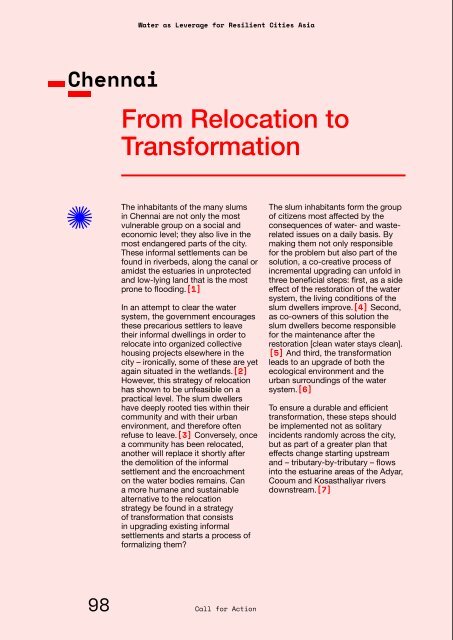Water as Leverage- Setting the scene for a call for action
- No tags were found...
Create successful ePaper yourself
Turn your PDF publications into a flip-book with our unique Google optimized e-Paper software.
<strong>Water</strong> <strong>as</strong> <strong>Leverage</strong> <strong>for</strong> Resilient Cities Asia<br />
Chennai<br />
From Relocation to<br />
Trans<strong>for</strong>mation<br />
[6]<br />
The inhabitants of <strong>the</strong> many slums<br />
in Chennai are not only <strong>the</strong> most<br />
vulnerable group on a social and<br />
economic level; <strong>the</strong>y also live in <strong>the</strong><br />
most endangered parts of <strong>the</strong> city.<br />
These in<strong>for</strong>mal settlements can be<br />
found in riverbeds, along <strong>the</strong> canal or<br />
amidst <strong>the</strong> estuaries in unprotected<br />
and low-lying land that is <strong>the</strong> most<br />
prone to flooding.[1]<br />
In an attempt to clear <strong>the</strong> water<br />
system, <strong>the</strong> government encourages<br />
<strong>the</strong>se precarious settlers to leave<br />
<strong>the</strong>ir in<strong>for</strong>mal dwellings in order to<br />
relocate into organized collective<br />
housing projects elsewhere in <strong>the</strong><br />
city – ironi<strong>call</strong>y, some of <strong>the</strong>se are yet<br />
again situated in <strong>the</strong> wetlands.[2]<br />
However, this strategy of relocation<br />
h<strong>as</strong> shown to be unfe<strong>as</strong>ible on a<br />
practical level. The slum dwellers<br />
have deeply rooted ties within <strong>the</strong>ir<br />
community and with <strong>the</strong>ir urban<br />
environment, and <strong>the</strong>re<strong>for</strong>e often<br />
refuse to leave.[3] Conversely, once<br />
a community h<strong>as</strong> been relocated,<br />
ano<strong>the</strong>r will replace it shortly after<br />
<strong>the</strong> demolition of <strong>the</strong> in<strong>for</strong>mal<br />
settlement and <strong>the</strong> encroachment<br />
on <strong>the</strong> water bodies remains. Can<br />
a more humane and sustainable<br />
alternative to <strong>the</strong> relocation<br />
strategy be found in a strategy<br />
of trans<strong>for</strong>mation that consists<br />
in upgrading existing in<strong>for</strong>mal<br />
settlements and starts a process of<br />
<strong>for</strong>malizing <strong>the</strong>m?<br />
The slum inhabitants <strong>for</strong>m <strong>the</strong> group<br />
of citizens most affected by <strong>the</strong><br />
consequences of water- and w<strong>as</strong>terelated<br />
issues on a daily b<strong>as</strong>is. By<br />
making <strong>the</strong>m not only responsible<br />
<strong>for</strong> <strong>the</strong> problem but also part of <strong>the</strong><br />
solution, a co-creative process of<br />
incremental upgrading can unfold in<br />
three beneficial steps: first, <strong>as</strong> a side<br />
effect of <strong>the</strong> restoration of <strong>the</strong> water<br />
system, <strong>the</strong> living conditions of <strong>the</strong><br />
slum dwellers improve.[4] Second,<br />
<strong>as</strong> co-owners of this solution <strong>the</strong><br />
slum dwellers become responsible<br />
<strong>for</strong> <strong>the</strong> maintenance after <strong>the</strong><br />
restoration [clean water stays clean].<br />
[5] And third, <strong>the</strong> trans<strong>for</strong>mation<br />
leads to an upgrade of both <strong>the</strong><br />
ecological environment and <strong>the</strong><br />
urban surroundings of <strong>the</strong> water<br />
system.[6]<br />
To ensure a durable and efficient<br />
trans<strong>for</strong>mation, <strong>the</strong>se steps should<br />
be implemented not <strong>as</strong> solitary<br />
incidents randomly across <strong>the</strong> city,<br />
but <strong>as</strong> part of a greater plan that<br />
effects change starting upstream<br />
and – tributary-by-tributary – flows<br />
into <strong>the</strong> estuarine are<strong>as</strong> of <strong>the</strong> Adyar,<br />
Cooum and Kos<strong>as</strong>thaliyar rivers<br />
downstream.[7]<br />
[3]<br />
[1]<br />
SCHOOL<br />
[2]<br />
[4]<br />
SCHOOL<br />
[5]<br />
98 Call <strong>for</strong> Action<br />
PART 1 / From Global <strong>Water</strong> Issues to a Call <strong>for</strong> Action<br />
[7]<br />
99


















